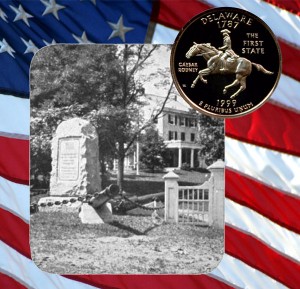Today, the Delaware State Quarter Coin remembers the first time the American Flag described earlier in the year by Congress was raised on the battlefield.
In the Four-Track News of July 1905, W. H. Richardson wrote of the Flag in Battle.
=====
Down in Delaware there is a stone memorial which tells the passer-by that “the Stars and Stripes were first unfurled in battle at Cooch’s Bridge, September 3, 1777.”
People who have not read their history over-carefully somehow have the impression that it was on the bloody field of Oriskany that “Old Glory” first blazed through the smoke of war, on August 6th of that year; but it appears that the famous banner improvised from a white shirt and an old blue jacket of a soldier and some strips from his wife’s red petticoat was hoisted as a signal of victory on Fort Stanwix after the work of that murderous day was done.
In other words, the flag was for the first time “on view” at Oriskany and “in business” at Cooch’s Bridge, Delaware.
General Howe had landed with his army about twelve miles below Elkton, Maryland, August 25th, 1777; and after a long journey round from New York he found himself almost as far from his objective point, Philadelphia, as he was when Washington faced and outplayed him, some two months before, in northern New Jersey, in his game of trying to get to the Quaker City by the overland route.
Howe’s designs in regard to his route from Elkton to Philadelphia were soon known to Washington, and so, for the purpose of harassing the invaders in every possible way, a corps of picked light infantry was placed in charge of General Maxwell.
The first collision occurred at Cooch’s Bridge, over the Christiana Creek .
As the Americans were overwhelmingly outnumbered by the British division under Lord Cornwallis, and as the enemy was supplied with artillery,—an arm which was altogether lacking in Maxwell’s party—they were forced to retire, losing forty killed and wounded.
The British loss was three killed and nineteen wounded.
Cornwallis’s headquarters were in the fine old house seen in the background of the picture.
This mansion, still in the Cooch family, was built in I 760 by the great great-grandfather of its present owners.
=====
In the American Monthly Magazine of January 1904, the Cooch’s Bridge Chapter of the Daughters of the American Revolution described their recent event:
=====
It is with pride that this little chapter tells her larger sisters of her summer work.
A delightful day was spent on “Flag Day” ‘with other chapters of the state, with our first and only and much loved state regent, Mrs. Elizabeth Clarke Churchman, in her charming home on the banks of the historic Delaware.
On September 3rd we celebrated the one hundred and twenty-sixth anniversary of the “skirmish” or “sharp fighting” at Coochs Bridge.
Howe’s army commanded by Lord Cornwallis, and a considerable number of the American forces, which were sent by General Washington to intercept them, commanded by General Maxwell, met at Coochs Bridge, New Castle county, Delaware, where a sharp fight occurred, the fore-runner of the “Battle of Brandywine.”
To the lasting glory of Delaware, the flag was first used in battle on land at Coochs Bridge, September 3rd, 1777.
This was the flag with its “thirteen stars and thirteen bars” as adopted by congress the preceding June.
At this historic spot the flag we honor and love received its first “baptism in fire and blood.”
Two thousand five hundred people gathered to celebrate this important event.
There were in attendance a detachment of regular troops of the coast artillery; Company E of the National Guard of Delaware; the governor of Delaware and his staff.
=====
From a different perspective, British Sergeant Thomas Sullivan wrote in his journal in 1777:
=====
Sept. 3d. On the march . . . fell in with a chosen corps of 1000 men from the enemy’s army, advantageously posted in the wood; and after a hot fire the enemy retreated towards their main body, by Iron Hill.
They made a stand at the bridge for some time, but the pursuing Corps made them quit that post also, and retire with loss.
In this skirmish we had three men killed, two officers and nineteen men wounded.
The enemy had the commanding officer of the advanced picquet and other officers killed and wounded, besides fifty men killed, with many more wounded.
We took up the ground the enemy left, and in the evening encamped there.
=====
The Delaware State Quarter Coin shows against an image of the monument commemorating Cooch’s Bridge with a flag in the background.
